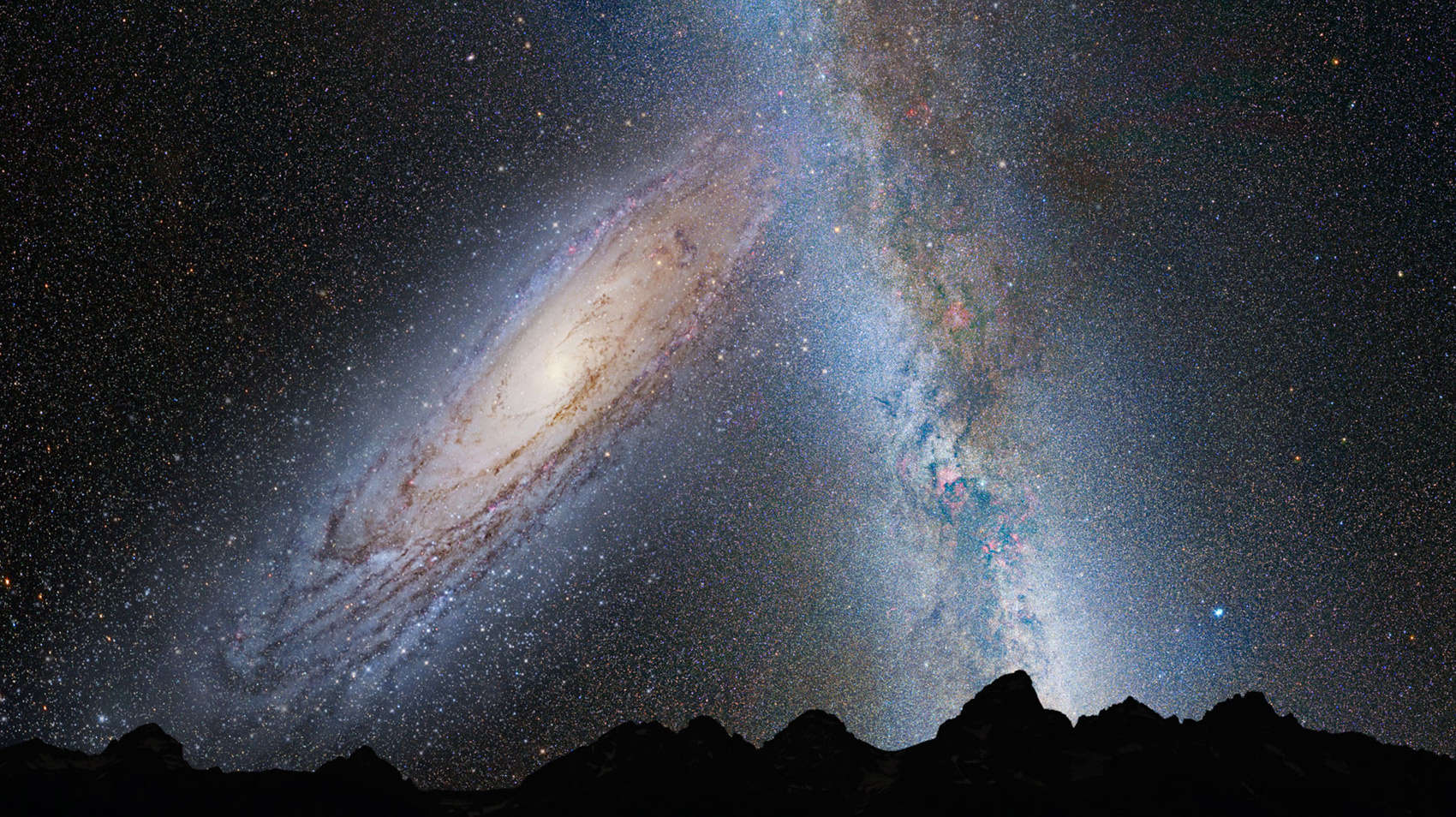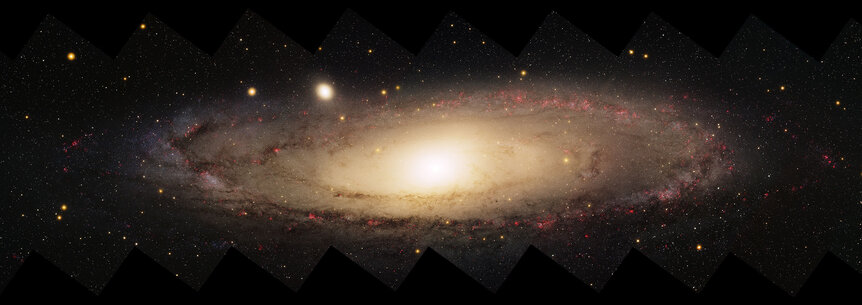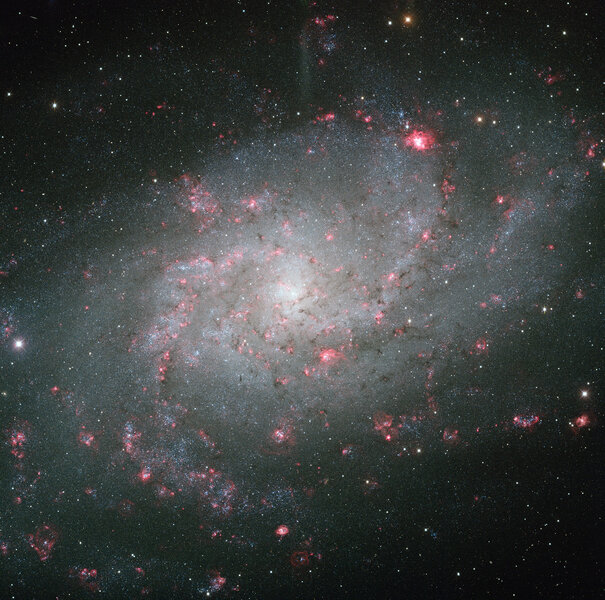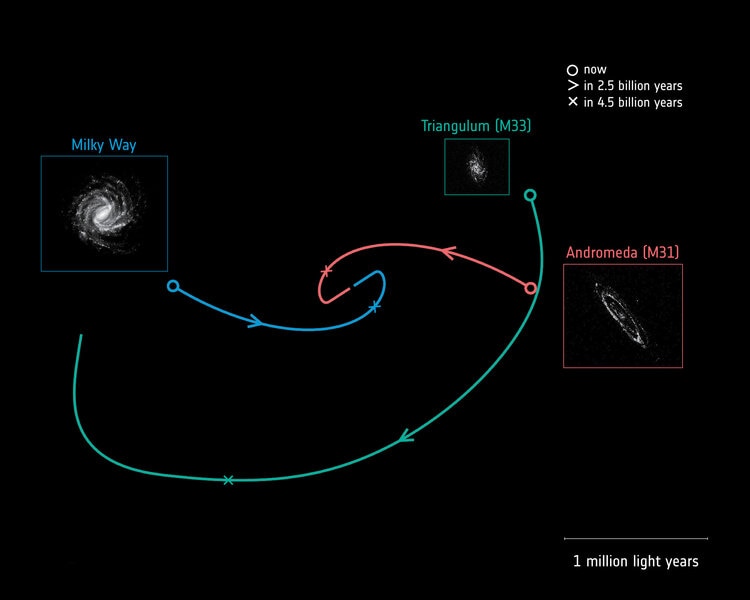Create a free profile to get unlimited access to exclusive videos, sweepstakes, and more!
Breathe easy: You have an extra 600 million years before Andromeda crashes into us

Hey, some good news: The impending colossal cosmic train wreck of the Andromeda galaxy smashing into our Milky Way and causing massive havoc and chaos on a literally galactic scale has been postponed. According to new measurements and calculations it’ll happen 4.6 billion years from now, not 3.9 billion.
Phew!
Our Sun is one of several hundred billion stars in the Milky Way galaxy, a sprawling flat spiral-armed disk of gas, stars, dust, and dark matter about 100,000 light years across. The Andromeda galaxy (aka M31) is roughly the same size, though more massive, and about 2.5 million light years away. Together our two spiral galaxies dominate the Local Group, a small cluster of a few dozen mostly dwarf galaxies. An exception is the Triangulum galaxy (aka M33, also a spiral), about a third the size of the Milky Way — bigger than most dwarfs but far smaller than us and Andromeda — and roughly 2.9 million light years away.
The behavior of the Big Three galaxies in the Local group has been a question for a long time. For example, Andromeda and Triangulum are much closer to each other than either is to us (the constellations of Andromeda and Triangulum, after which the galaxies are named, are next to each other in the sky). Does Triangulum orbit Andromeda? Both show evidence of distortions in their disks as if they may have interacted some time in the past, and gravitationally disturbed each other. Is that the case?
A bigger question involves the future. We’ve known for many decades that Andromeda is headed toward the Milky Way, but is it headed directly toward us? In other words, should we expect a head-on collision, or will the two pass in the night? A few years ago, Hubble was used to very finely measure the positions of stars in three different patches of Andromeda over the course of 5 – 7 years. Careful analysis indicated that Andromeda was very slightly sliding to the side as it approaches us, meaning it’ll be a very close pass occurring in about 3.9 billion years. So Andromeda will miss us, but the gravity of the two behemoths will draw them back together, causing them to merge into a single galaxy some hundreds of millions of years later.
But now we have new observations! Astronomers used new data from the European Space Agency’s Gaia satellite to measure the motions of both Andromeda and Triangulum, and have found some very interesting things. For one, it looks like Triangulum is not orbiting Andromeda, and is currently making its first pass at the much bigger galaxy. The distortions seen in their structures are probably therefore due to them eating smaller dwarf galaxies, which happens a lot.
But the bigger news is the refinement on the collision circumstances. According to the new numbers, Andromeda will still miss us on its first pass of the Milky Way, but the distance at which it will pass us is larger than previously thought. Earlier estimates had it missing us by about 100,000 light years; the new results more than quadruple that to 420,000 light years (that’s measured as the distances between the galactic centers). That’s much farther out, but not enough to change our fate: merger.
As Andromeda passes us the gravity of each galaxy will tug mightily on the other. Stars on the near side of either galaxy will be pulled toward the other, drawn out into long streamers called tidal tails. Many stars will be thrown completely out of both galaxies, sent into intergalactic space. The mutual gravity will also slow both as they pass, and they will eventually stop, then draw back together. The result is a direct collision and then a merger, with both galaxies coalescing into one, much larger, galaxy. This will likely take longer than previous estimates as well, since they won’t pass quite as close together as first thought, so the effects of gravity are weakened somewhat. But it’ll still happen.
It’s unclear what will happen to the Sun during all this. Orbits of stars all over both galaxies will be disturbed, and there’s a chance we’ll be ejected. There’s a better chance the Sun will continue to stay inside the new galaxy (sometimes called, awkwardly, Milkomeda), just on a vastly different orbit. But note the timing: This will happen in 4.6 billion years, which is well within the Sun’s lifetime. The Earth may still be around then too … though in a fun coincidence literally twice its current 4.6-billion-year age. So maybe someone may still be here on this planet to witness all this. That’s a cool thought.
I’ll note these new Gaia data are consistent with older observations on the motions of Triangulum and Andromeda, but it’s also possible they’re not quite as accurate. Over time, as Gaia continues to observe the skies, these numbers will get better because the distances the stars move in its field will be greater. The next release of updated Gaia observations is expected to come next year, so I expect we’ll be hearing lots of refinements in previous results announcements shortly thereafter.
And don’t get the wrong idea; Andromeda is still on its way, and the collision is inevitable! The real question is how close will it pass us, and when. That will affect what happens to the Sun, too (we might be on the side of the Milky Way nearest Andromeda during the close pass, or all the way clear across on the other side), so it’ll be very interesting to find out how this story will change over the coming years. Hopefully just a few, and not a few billion.






























